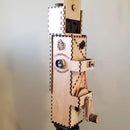Introduction: Human Sized Telepresence Robot With Gripper Arm
MANIFESTO
A frenemy of mine invited me to a Halloween party (30+ people) during a pandemic so I told him I would attend and went about rage-designing a telepresence robot to cause havoc at the party in my place. If you're unfamiliar with what a telepresence robot is--basically it's a robot I can dial into it over the internet and control it like a puppet from anywhere in the world. In this case, it's the size of a human and designed to be able to steal drinks and stink up the place.
About this Telepresence Robot
The robot has free range of motion (left/right/forward/back) and a motorized tilting holder for a Galaxy 10.1" tablet. My robot has a telescoping robotic arm made from an IKEA lamp and a custom gripper claw with a pressure sensor built into it. This utilizes a custom linear actuator made from a continuous rotation servo. The robot is also equipped with a febreeze pumpkin spice sprayer that goes off every 30 seconds and a drum that releases candy corn and toy spiders/ants intermittently onto the floor. (HAh HaH Ah)
How Does It Work Though?
The whole thing is based in arduino uno and utilizes a DMTF Shield (takes 2 weeks to get in California from the website). The shield converts dial tone frequencies into commands for servos. Basically you use a dial tone simulator online and hit keys 1--9 to move the servos. It is the audio tone itself that issues the command to the shield. I added the website but any similar tone generator will work. Bear in mind you will need to combine your computer audio with your microphone audio--usually using a feature called stereo mode on PCs. This makes it so the tablet/phone receiving the call can hear the tones you play.
Acknowledgement!
I would like to acknowledge Instructables Maker Randofo. I based my platform on his original work. The original code for tilting a phone/tablet and moving around on 2 continuous rotation servos was authored by him. His modified DMTF code and library are intrinsic to this make! I have expanded on the code significantly but it is not my work. https://www.instructables.com/Telepresence-Robot-... see his instructable! He is an amazing instructables publisher!
Onward Minions!
This thing was a ton of fun to build and the party I'm attending with it is on Saturday 10/24. I will add video of the carnage later! If you have any questions, let me know. I provided a BOM that is complete except for screw sizes and odds/ends that are really determined by the direction you take the build. When looking at the photos, remember it's a Halloween Party Robot so there is non-essential junk glued to it to make it look cool!
Supplies
https://onlinetonegenerator.com/dtmf.html
Arduino UNO.....................................Amazon.com
DMTF Shield.....................................DFROBOT.com
Microphone Amp...............................DFROBOT.com
Force Sensitive Resistor 10k............Amazon.com
7.4v LiPo Battery...............................Amazon.com
IKEA Lamp........................................IKEA
3 Continuous Rotation Servos..........ServoCity.com
2 180 degree Servos.........................ServoCity.com
8mm Brass or Aluminum Shaft.........Hardware Store
Hardware for Locomotion..................ServoCity.com
PVC Parts.........................................Hardware Store
3D Printer............................Helpful but not essential (you will need to lean on a friend or order out)
Laser Cutter........................Helpful but not essential (cardboard and hot glue also works!)
Step 1: Gripper Arm and Sensor
I use a continuous rotation servo in the lamp arm for the linear servo mechanism. I use foam in the gripper claw with a force sensitive resistor pad behind it so that the gripper doesn't destroy itself or crush what it is trying to pick up. I also mounted an LED on the gripper arm that lights up when a pressure threshold is reached. Bear in mind, the code also stops the servo from moving once that pressure threshold is reached.
When I 3D Print parts that are going to be used for mechanical, repetitive motion I use PETG Filament. It has help up very well to repeated abuse. I use infill of 50%.
The files I use are in the format to be opened by 3DBuilder and Adobe Illustrator. If you are unaware, 3DBuilder is a free 3D design software that comes pre-loaded on PCs. It's like the MSPaint of 3D software. I used it to create all of the 3D elements in this build. But man, I need to learn Blendr (also free and has many, many cool features).
Step 2: The Galaxy Tab a Holder
This piece is completely 3D printed. Sorry if you don't have access to one. I was really into building cardboard models before I got my printer and I'm certain this piece could be made with hot glue/wood dowels/cardboard.
As it is now, I used 8mm inside diameter ball bearings and 8mm brass stock. I also use an 8mm collar with a set screw. This adapts the mechanism to the servo. I use the round servo attachment. This is designed to be modular and the design works well so far for me.
Incidentally, the microphone amplifier is hot glued near the speaker output!
Attachments
Step 3: Movement
It is not critical that you exactly copy my method of movement--in fact this triangle shape is honestly not that stable. But I use the continuous rotation servos and attach them to wheels. For handling any kind of weight, you need to take the weight off the servo and put it on the wheel/axel/ball bearing.
Attachments
Step 4: Wiring and Coding
Sorry about the diagram. I used MSPaint. You WILL need to adjust the buck converter to make it 5v. Get out a volt meter and a small screwdriver. Yup, keep turning that little adjuster screw.
The arduino code is here as well as the DMTF library that you will have to add to arduino IDE library.
There is an error on diagram. It refers to an 11v battery. I ended up using a 7.4v LiPo battery instead. Feel free to adjust the battery you use to suit your power requirements.
Step 5: And You're Ready to Cause Havoc
You dial into your tablet and take a stroll around your friends house, stealing drinks and chasing people. Have fun with this. Expand the code. Push the limits!









